Martello Towers in Sussex
There were 47 Martello Towers built along the East Sussex coast, from No.28 in Rye to No.74 in Seaford. There were 46 between Rye and Eastbourne and one at Seaford. There were 11 towers between Rye and Cliff End.
Martello Towers in Sussex:
Rye No.29 no longer exists
Rye to Bexhill Nos. 31 to 54 no longer exist
Norman's Bay Nos 56 & 57 no longer exist
Pevensey Bay No.63 no longer exists
Pevensey Bay No.65 no longer exists
Eastbourne Nos. 69 to 72 no longer exist

Martello Tower No.28 was the first Tower in Sussex, built on the west bank of the River Rother and commanded the then entrance to the Harbour. It is located in a moat and is known as the 'Enchantress Martello Tower'.
Martello tower No. 28 survives well, and retains many of its original components and associated features, including its glacis bank.
Furthermore, when viewed as one of a series of three towers, specifically designed to protect Rye Harbour and the sluices of the contemporary Royal Military Canal, No. 28 contributes towards our understanding of the strategically planned integration of the martello tower system and its role in the defence of Britain during the early 19th century.
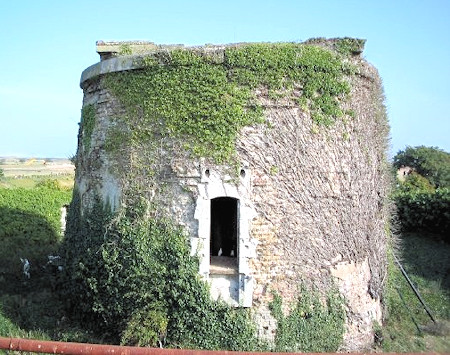
Martello Tower No.28
The upper half of the tower protrudes above the lip of the brick retaining wall of the moat, which encircles the base at a distance of around 10m and was intended to protect the tower against both cannon fire and, if necessary, ground assault.
Soil was deposited against the outer face of the retaining wall to form an earthen bank, or glacis, which slopes away from the lip of the moat for a distance of up to around 28m. A portion of the surviving glacis in the east and south east has been partly removed, exposing the buttressed wall of the moat. The tower was constructed on three levels, with battered (inwardly sloping) walls, designed to deflect cannon shot, ranging from 1.6m to 4m in thickness, the most substantial section being on the seaward side.
 Historic England Listing
Historic England Listing
Martello Tower No. 30 stands opposite the turning to Rye Harbour from New Winchelsea Road. It protected the sluices of the Brede and the Tillingham rivers.
Martello tower no 30 survives well and retains many of its original components and associated features, including much of its glacis bank. Furthermore, it was one of only two towers to have been equipped with a cunette at the foot of the glacis slope; the other was situated at Walton Ferry in Suffolk.
The presence of a cunette and the unusual, inland location of the tower provide a significant contribution towards our understanding of the need for variations in the basic design of the towers, and the strategic integrity of the martello tower system.

Martello Tower No.30
The roof retains many of its original features including the inner, and part of the outer, iron gun rails.
This Martello Tower is privately owned and has recently been stripped of vegetation revealing it to be in good condition.
Martello Tower No. 55 Normans Bay
Martello Tower no 55 survives well and retains many of its original components.
During the 19th century, tower no 55 became one of four Martello towers to be fitted with a semaphore machine, and in the early 1900s, it was used for a series of wireless telegraphy experiments.
The small, ruinous lean-to building, of concrete block construction, and its associated cistern, built against the north-western side of the tower, are considered to be later 20th century additions.
The tower was converted conversion to a Battery Observation Post during Second World War. Evidence for of this coastal defence survives in the form of two anti-tank blocks, of unusual design, located close to the base of the tower.
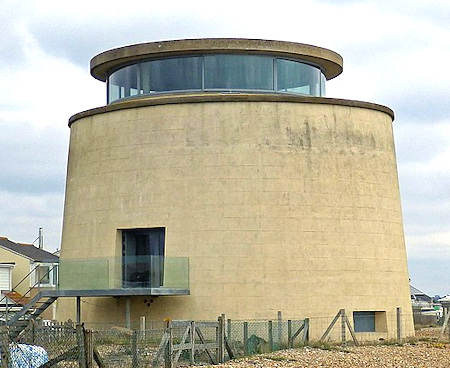
Martello Tower No.55 in 2018
After the Second World War, it was left empty until 2004 when it was sold for £285,000 to a private buyer who subsequently converted the tower into a private residence.
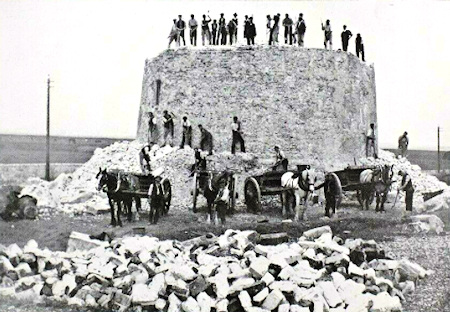
Martello Tower No.59 being demolished in 1903
Martello Tower No.60 Pevensey Bay
This Martello Tower has been converted into a private dwelling in the standard style. Was sold in 1986 to a private buyer who subsequently converted the tower into a private residence.
The new owners found the tower was just a mere shell with no floors, doors or services, and jagged holes in the walls where a previous owner had tried to blast out the brickwork to put in extra windows.
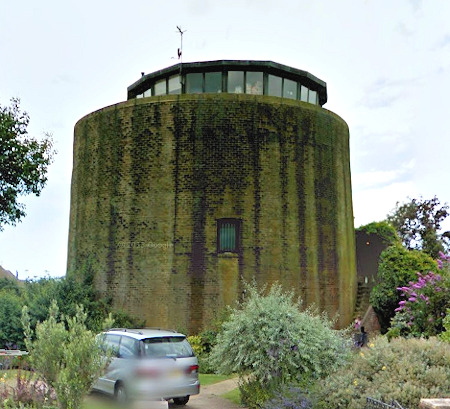
Martello Tower No.60
Martello Tower No.61 Pevensey Bay
Martello Tower No.61 stands about 200 metres from the sea and has been a private residence for some time now. It was for a time used by the marine artist Val Prinsep as a residence in the early part of this century, and it was from this tower that some of his seascapes were painted.
By the 1930′s, the tower was being used as an enormous shingle grader, with a hoist taking shingle up to the roof. It later had a concrete roof in 1940, for which the gun carriage was thrown off the tower, and left in pieces on the beach.
The new roof came with an extra cell built on top to contain range-finding equipment for a gun battery of three 5.5″ guns installed on the beach in front of the tower in 1941.
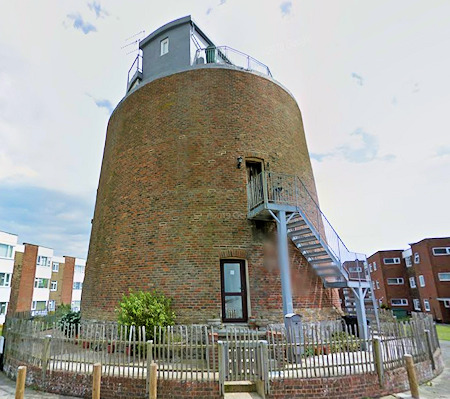
Martello Tower No.61
Blocks of flats were erected around the tower in the late 1960′s to create the Martello Estate, with the tower as the centrepiece.
The tower stood derelict for some time. The gunslits on the roof were glazed in 1992, and an original cannon mounted on the parapet prior to the tower being put up for sale for £84,950 in 1991.
Further work has recently been carried out, with a viewing platform with barriers being created, and proper doors and windows added.
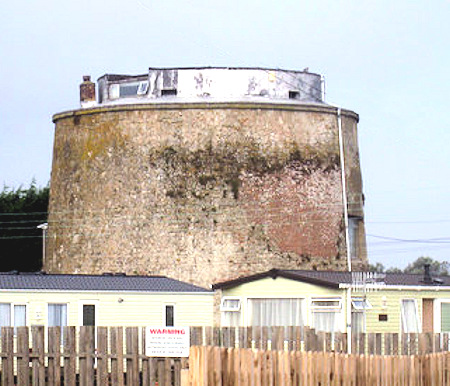
Martello Tower No.62
Martello Tower No. 64 Pevensey Bay
The brickwork on this Martello Tower is in a poor state, a door has been added at ground level and remains padlocked.
The roof space is partly concealed beneath a concrete Second World War gun emplacement from when the tower was used as a machine-gun post and has emplacements on the roof and concrete embrasures where the windows used to be.
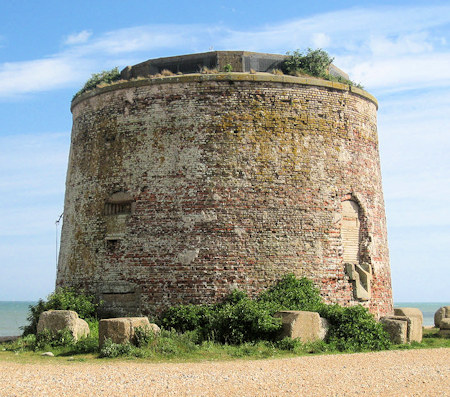
Martello Tower No.64 in 2010
Martello Tower No.66 Eastbourne
This Martello Tower is located on Langley Point, close to the Sovereign Harbour development.
Martello tower No. 66 survives well and retains a substantial proportion of its original components and associated features, including its original gun barrel, which is a rare survival amongst martello towers.
During World War II, a concrete gun emplacement was constructed across the roof of the tower, and this, in turn, supports a later, temporary coastguard station.
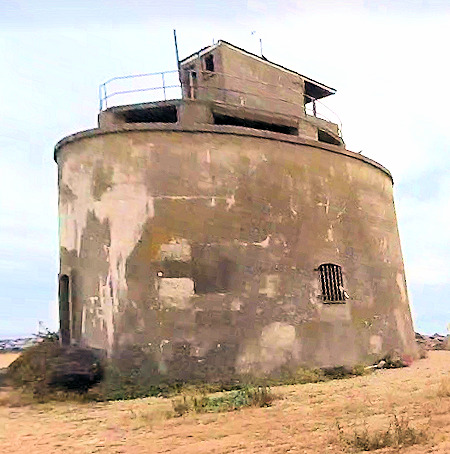
Martello Tower No.66
Despite these later additions, the gun platform retains many of its original features, including the inner running rail and the original gun barrel, which lies unmounted, within the roof well. The coastguard station on the roof of the tower still remains.
The tower now stands empty.
This tower stood atop St Anthony's Hill and is now built over - the ditch around it is now The Circus. The tower was purchased by Alderman Wenham in 1904 and later demolished so a house could be built on the site. The base of the tower is apparently incorporated into the house named The Mount (built c.1912)
This one was located on St Anthony's Hill. Demolished having been used as target practice when testing the new rifled Armstrong Guns in 1860. The area is now built over although the circular ditch is tracable and known as the circus.
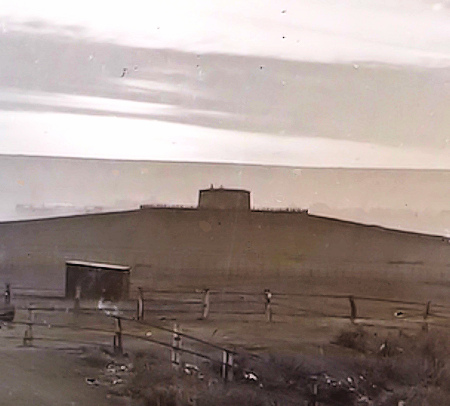
Martello Tower No.68 (now demolished)
Martello Tower No. 71 was built during the early 19th century and abandoned after 1850.
It was destroyed in 1860 when it was used for target practice by the Royal Artillery, who were testing the new rifled Armstrong guns.
see article in the London Illustrated News 25 August 1860 below
There is now no trace of the tower. This area was surveyed as part of the South East RCZAS NMP project. No remains of the former 19th century tower were visible on historic or modern aerial photographs.
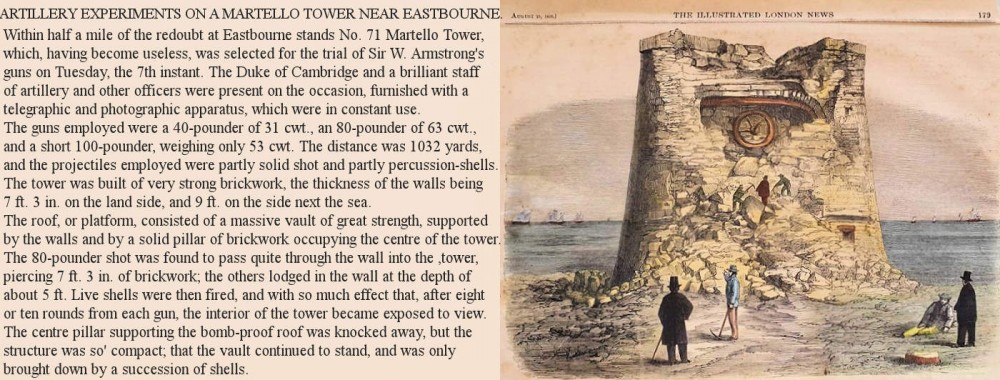
Martello Tower No.73 Eastbourne
Martello Tower No.73 is known as 'The Wish Tower' and stands in a prominent location on Eastbourne seafront. Between 1812 and 1860 the tower was used as a coastguard station to protect the town against smuggling which was rife at the time.
In 1873, when the immediate danger of invasion had finally passed, the tower was decommissioned by the War Office. Shortly after this it was leased by the Eastbourne Local Board and rented to the Hollobon family who ran the tower as a geological museum until about 1930.
During the Second World War, the tower was adapted with a structure on the roof and naval guns in front of the tower and used as a battery. In the late 1950s, the tower was nearly demolished. It was 'scheduled' as a monument and some repair work carried out. At the same time, the popular "Wish Tower Cafe" was built on the site which is now the Western View Cafe.
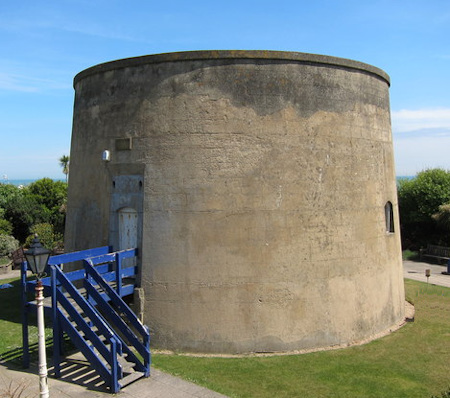
Martello Tower No.73
In the 1970s a military museum was based at the tower which operated until the 1990s when a puppet museum took its place.
The tower was empty between 2001 and 2013 after which time the Wish Tower Friends started to organise tours and occasional events.
Despite continued water ingress and deteriorating render, the tower remains broadly in a reasonable condition. It contains many original features of historical significance and is well worth a visit on occasions when it is open to the public.
Martello Tower No.74 is located on the seafront in Seaford on land purchased in 1806 and the tower built between then and 1810 at the cost of £18,000 using half a million bricks. There were to be two others, which would have provided covering fire, were planned but never built so this tower was the last in the chain starting with No.28 in Rye.
A waterproof brick 'dry moat' was made before the construction of the tower could be started because it was below sea level. This had a central slate lined cistern to receive rainwater through pipes built into the walls from the roof. Above this, a three-storey tower consisted of a storage area and gunpowder magazine at moat level, a living area at ground level and the roof housed the 24 pounder cannon. (since replaced by a 32 pounder.)
The access to the tower would have been across a 'draw bridge' on the landward side of the tower, unfortunately, this was destroyed when the cannon fell on it while being moved in 1880.
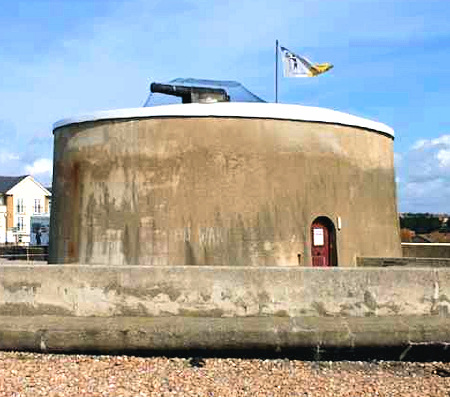
Martello Tower No.74
When the war with France ended in 1815, the tower's military life came to an end, but the strong construction later provided homes for Signallers, Excise men, a company of sappers and miners. By 1873 the tower was in danger of being washed away and it was sold by the War Office in 1880.
In 1910 the Tower changed hands again and the new owner replaced the Draw Bridge with a railway carriage and opened Tea rooms and a roller skating rink in the Moat and finally built living accommodation on the roof, but this has since been removed. In the mid-1930s, the seaward side of the moat was covered with decking to link the east and west Esplanade.
In the early 1970s, the accommodation on the roof was removed and the tower restored by Lewes District Council to be similar to its original appearance.
it is now open to the public as a museum
After the Napoleonic Wars the towers were occupied by personnel of the Coastal Blockade established to combat smuggling.
The Coast Guards succeeded them in 1831, "a set of regularly appointed men of respectable character under the command and direction of able and intelligent naval officers". The 1841 and 1851 Census returns show that Towers Nos. 31-38 were occupied by Coast Guards and their families.
There was no tower between 29 near Rye Harbour and no. 31 at Dog’s Hill. Winchelsea Beach. The area between was an expanse of undrained marsh and contained "great Morasses" so that towers were considered unnecessary. In 1804 the beach on which the reserve is sited was scarcely formed.
The stretch of farmland now lying on the seaward side of The Ridge and the Watch Houses, the Nook on the OS maps, was in 1804 a tidal inlet and an outlet from the "new" Rye Harbour at Winchelsea Beach which had been abandoned in 1787.
Census returns show that Towers Nos. 31-38 were occupied by Coast Guards and their families.
In 1851 in Tower No. 32 there were two families with a total of l3 children.
Towers 28. 31, 37 and 38 accommodated men of the Royal Artillery Coastal Battery, and Towers 32 and 34-36 were uninhabited. At the time of the 1871 Census Tower 28 still housed six men of the Royal Artillery and No.33 a Greenwich pensioner; in No.38 was a Sergeant of the Royal Artillery. By 1881, Coast Guards were housed in their own buildings.
Tower No.37 was used in 1886 for experiments with "protected" gunpowder which were fully reported with a picture in the Illustrated London News of 30th June.
In 1872 Towers Nos. 39 and 38 were used for experiments on the stability of gun-cotton. After the experiments, the two towers were blown up with 800lbs. of gunpowder in No.39 and 200lbs. of gun-cotton in No.38, a scene witnessed by hundreds of on-lookers.
In 1851 in Tower No. 32 there were two families with a total of l3 children. Yet, in 1861, no tower had any Coast Guards in it;
Towers 28. 31, 37 and 38 accommodated men of the Royal Artillery Coastal Battery, and Towers 32 and 34-36 were uninhabited. At the time
of the 1871 Census Tower 28 still housed six men of the Royal Artillery and No.33 a Greenwich pensioner; in No.38
was a Sergeant of the Royal Artillery. By 1881, Coast Guards were housed in their own buildings.
In 1872 Towers Nos. 39 and 38 were used for experiments on the stability of gun-cotton, experiments which the Hastings and St. Leonards News of 26th April 1872 reported as showing that "gun-cotton could not be relied on.... and must be treated with proper and due caution". After the experiments the two towers were blown up with 800lbs. of gunpowder in No.39 and 200lbs. of gun-cotton in No.38, a scene
witnessed by hundreds of on-lookers "in delightful weather", and one "which they could not fail to regard as interesting".
Martello Tower No.74 was the most westward tower built, but this was not always the plan. Find out more at The Martello Towers WEST of Seaford!




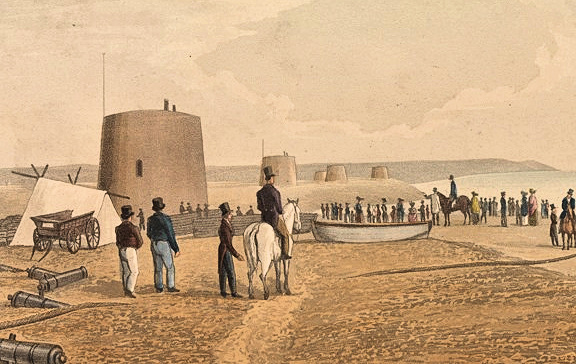
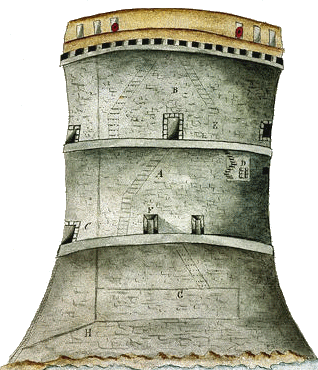


 Red Dragon I.T. Ltd.
Red Dragon I.T. Ltd.